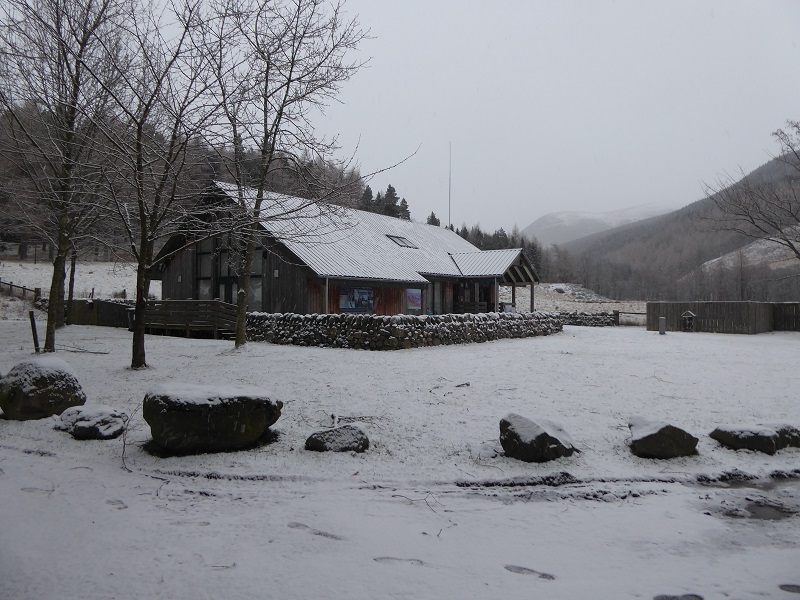
Last weekend was the first time I had visited Glen Clova for several years. The public road up the glen terminates at a Forestry Commission (paying) car park and visitor centre. In contrast to the Loch Lomond and Trossachs National Park, which has installed gates across car parks which it then locks, the public are allowed to park vehicles here overnight. I was pleased too to find the disabled toilet at the Visitor Centre is accessible to visitors 24 hours 365 days a year (for how the LLTNPA operates its toilets see here). The basic infrastructure to support visitors is therefore in place and north of the car park there is a great flat area with picnic tables.
However, other things are going badly wrong and, just like in areas of the Loch Lomond and Trossachs National Park, the overwhelming impression for anyone bothering to read the signs – and I am now an inveterate reader of such signs – is No! You can’t do that. This post takes a look at the legal basis and implications of all the NO signs.
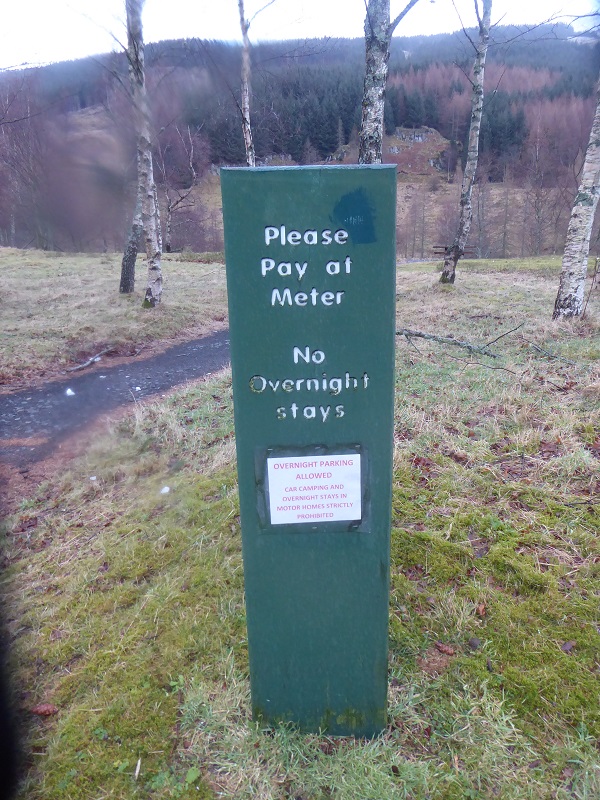
The last time I had stayed in Glen Clova, to go rock climbing on Red Craig, we had slept in my climbing partner’s van. The Forestry Commission is now apparently trying to ban this – as it has done on so many of its car parks across Scotland. It appears however as yet to have put no byelaws in place to make the ban here enforceable. If you ignore the signs therefore the most the FCS could do at present is try to seek an interdict to stop a person doing this again. Whatever the legalities, there is no justification at all for the Forestry Commission to try and stop people staying overnight here. For anyone wanting to visit Glen Clova in a campervan there are very few places to stop off on the road apart from the Glen Clova hotel and a car park for hillwalkers on the Rottal Estate. The Glen Clova/Glen Doll Forest carpark is easily the best place to stay and yet the Forestry Commission wants to ban this. So much for it supporting tourism and enabling people to enjoy the great outdoors.
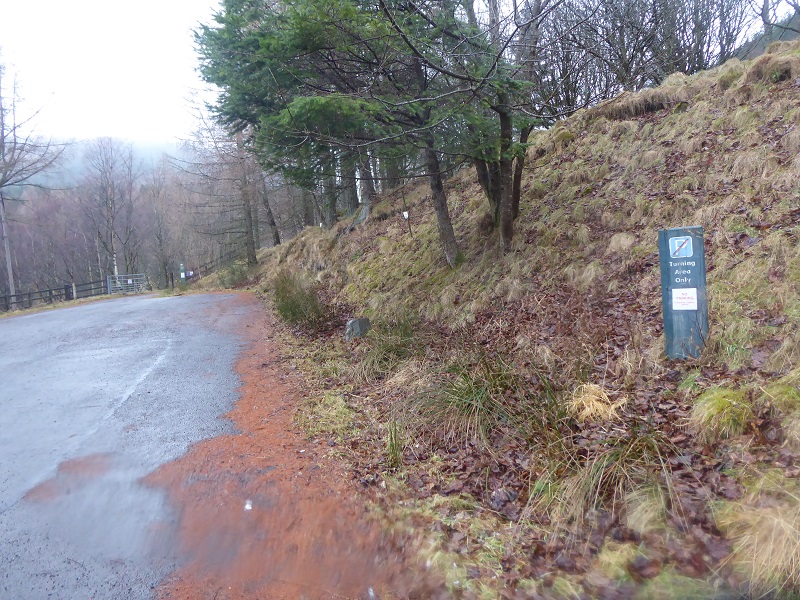
In order to prevent people trying to avoid the charges for using the carpark or stopping off in campervans overnight, there are half a dozen no parking signs at the road end claiming it is needed for turning when there is a large car park where most vehicles could turn. The legal basis for these signs is also unclear: the public road is not a clearway and you have a legal right to stop overnight on the road network unless a traffic regulation order has been put in place that says otherwise. Of course it would be much better if people used the car park but the inevitable consequence of car park charges and trying to ban overnight stays there is people will try and stay elsewhere.
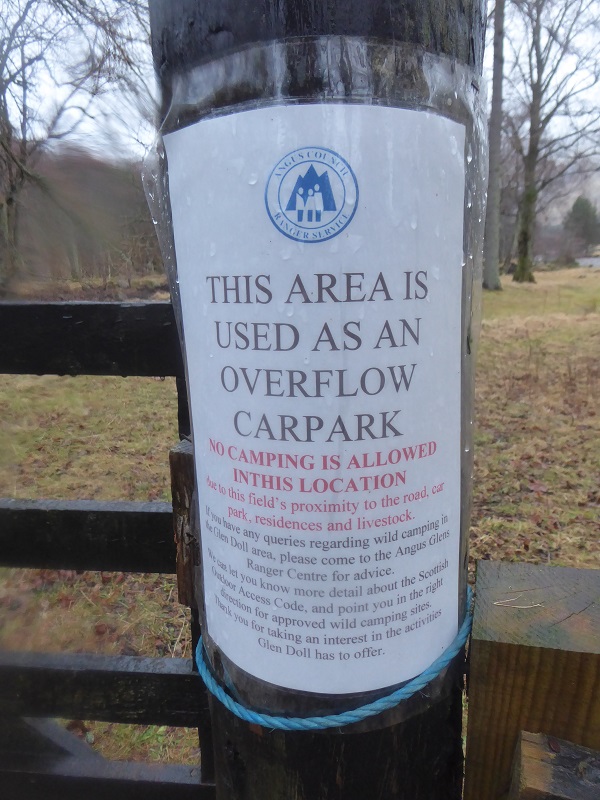
As for camping, the field behind this sign and beside the river used to be used as an informal campsite. I know because I camped here many years ago. Ignore the nonsense of the field being needed as an overflow carpark in the middle of winter. The sign is contrary to access rights. The nearest accommodation is Scott Lodge, operated by the Boy’s Brigade on the other side of the river, hardly a residence, and I find it hard to believe that either they or the Carn Dearg Mountaineering Club, which has a hut nearby, would object to camping here. There are no other residences nearby. As for the claim that camping is not allowed because the field is close to the road this is wrong legally: you have the right to camp anywhere you have access rights.
Now I am not claiming here that this field is the best or most suitable place for camping hereabouts – I personally believe the flat area by the river north of the car park, beyond the picnic tables (sorry no photos) is more suitable and would be preferred by most people wanting to stop off overnight in tents (its also closer to the toilet). The signs however say that no camping is allowed there either. Instead there is this:
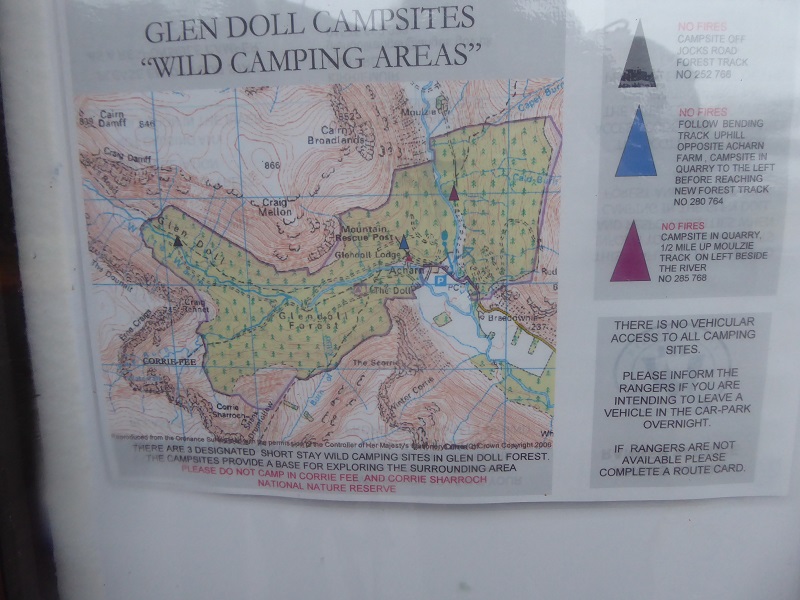
This sign appears designed to mislead in respect of camping and access rights. Our public authorities have first tried to persuade people that the right to camp under access rights was intended only to apply to people camping well away from the road, a practice which is now often termed “wild camping”. While the Loch Lomond and Trossachs National Park Authority has been the public authority which has most forcefully tried to convince people of this, other public authorities have tried to sell the same message. But the FCS in Glen Doll and Glen Clova has now gone a step further intrying to direct people to “designated short stay wild camping sites”. The implication of course is that in areas which are not designated, you should not “wild camp”. Accept this, and that’s the right to camp under our access legislation totally undermined.
I am not against the Forestry Commission pointing people to areas that might be good for camping within their landholdings but this is NOT what is happening at the head of Glen Clova. FCS is trying to stop people camping on any of the good sites by the river near the road end and instead trying to force people to camp in the old quarry or other areas further afield. The closest good camping place to the road end they recommend is 1km away, despite there being several good flat areas for camping within sight of the car park. The solution of course is for FCS and other partners to provide a basic campsite somewhere by the river at the head of the Glen not too far from the car park. That would be a welcome facility which most campers would be welcome. For campervanners, the existing car park provides an ideal base.
As final confirmation that our public authorities do not understand access rights and are mis-using the Scottish Outdoor Access Code consider this sign (approved by SNH, Angus Council and FCS):
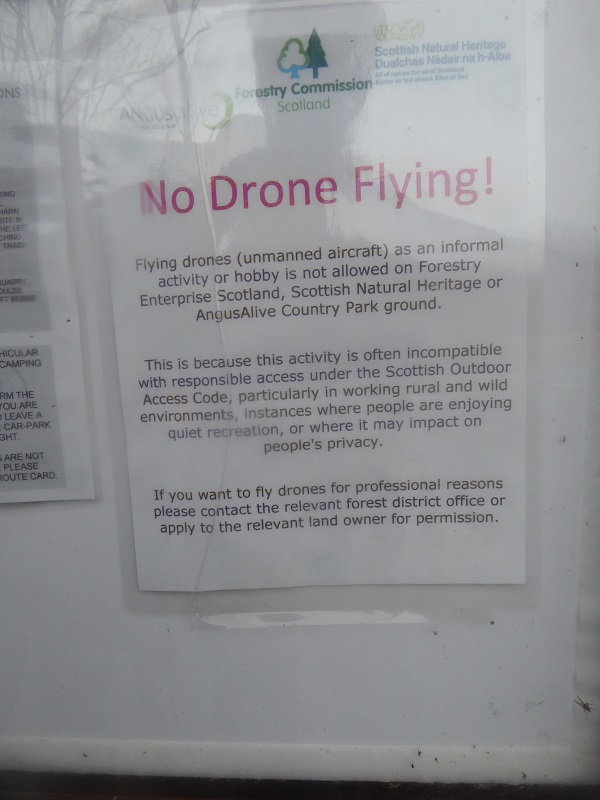
Access rights do not cover motorised vehicles, which almost certainly covers drones, and there is no reference in our access legislation to drone flying or anything similar. Its safe to conclude therefore that flying drones is a leisure activity, like angling, which is not included in access rights. To claim therefore that the activity “often” contravenes the Scottish Outdoor Access Code is totally misleading. The SOAC is guidance about how to undertake activities which come under access rights NOT on how to undertake activities which are excluded. Even worse is then to try and claim that because drone flying is “often” (whatever that means) incompatible with other activities, it should NEVER take place. This is flawed logic.
Our public authorities should not therefore be referring to SOAC to try and dissuade people from flying drones and they have no powers under the access legislation to stop such activities. What they could have said is that drone flying is not covered by access rights. However, if they really want to stop people flying drones on land, they need to resort to other legislation. FCS, Angus Council and SNH all have powers to regulate activities that fall outwith access rights by byelaws under other legislation and they should be able to use those powers rather than abusing our access legislation.
I am not claiming here that drone flying cannot cause problems for recreational users and indeed interfere with the enjoyment of access rights – drones buzzing above your head is irritating at the best of time and at worst, for example if you are climbing, can be positively dangerous. Drone flying may therefore need to be regulated but you cannot do so under our access legislation and this seems an appropriate matter for the civil aviation authority.
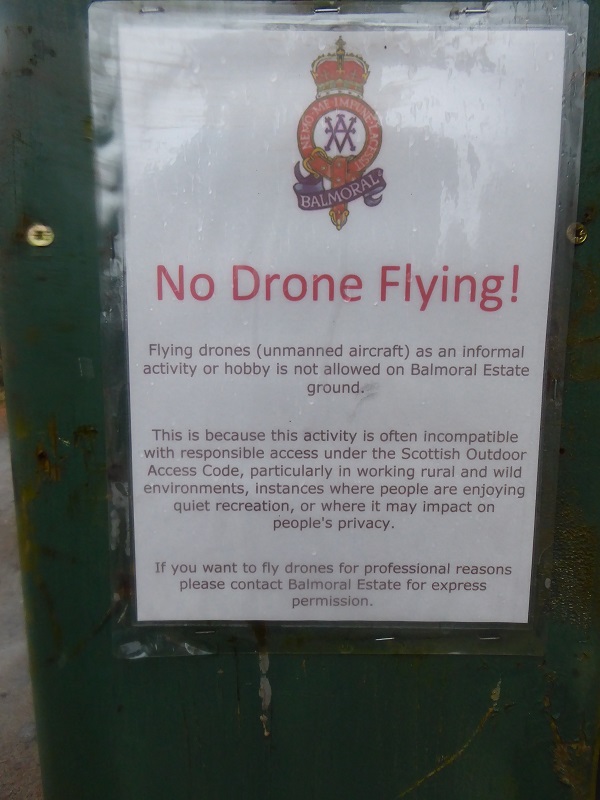
Near the first sign was a second similarly worded sign from Balmoral Estate. It appears Balmoral have adopted this sign on the advice of the three public authorities. My guess is that it may be the existence of the royal residence over the hill which has led to the attempt to stop drone flying in Glen Clova. If so this just reinforces the point, our access legislation is not an appropriate means either to try and secure the safety of the royal family or the general population, for example at airports.
What needs to happen
On the positive side none of the signs at the head of Glen Clova with their various misguided attempts to manage visitors have been endorsed by the Cairngorms National Park Authority. As the responsible Access Authority they are therefore in a good position to step in, engage with wider stakeholders and help sort out the whole mess. This should include removal of all misleading signs and the creation of a basic campsite/recommended camping area close to the road end.
Meantime local SNH and FCS staff could usefully seek advice from their headquarter staff before adding their names to signage in future while FCS nationally needs to review its policy of trying to stop overnight stays in its carparks by campervans. We need public authorities operating in National Parks to exemplify best, not practice – that was what the National Park Plan was supposed to be all about.
There was an official campsite in Glen Doll. It wAs in the field on the left as you crossed the bridge into the car park area. It also had a toilet block. It was shut a number of years ago as it was to popular and the claim was to much effluent was going into the river. The rangers station toilets go to a septic tank, you do not want to be in the car park when the tanker comes to empty it!
Bill, that’s the same field where the no camping sign featured above is now!
I asked the FC last year about using their car park at Glen Clover for an overnight with my campervan in support of prep for a charity event. They refused but said the ranger might allow it – he didn’t. They suggested using a partly dug out quarry that is a few hundred metres down the road from them. Instead I just reduced the period we were there (no overnight stop) and used a car. As it turned out there was a campervan parked up that had clearly been there overnight, parked at the end of the FC car park doing no one any harm – and apparently undisturbed.
It’s fine if campervans are allowed on an ad hoc basis, but you can’t make any plans if there is no certainty about whether you’ll be turned away or not – which is hardly a basis for increasing access to this lovely part of the country. I did wonder on what legal basis the FC could prevent camping.
Thanks Andrew, info very helpful – I am going to write to FCS about the way they exclude people from the countryside and have been in correspondence too with CNPA who have said they will talk to FCS. The mismanagement at the head of Glen Clova is not unique though and there are a number of examples on FCS land – so, I think its time the recreational organisations started to challenge FCS nationally about this. FCS is far from all bad and their approach to visitors varies greatly from area to area and its seems to be attitudes of local management which determines whether places are managed for people or to exclude people.
i know that site well beside the bridge took my son there several times for an overnight stay.
it was closed at the time of the foot and mouth outbreak, and has been closed ever since.
The toilets were a great bonus as it was never easy to get a 5 year old to poo in the bushes.
i agree we need to challenge these organisations that are detrimental to the right to roam and
experience the countryside.
Very interesting that the campsite was closed at the time of Foot and Mouth. That crisis had a huge impact on our access legislation as the failure of landowners to take down the “countryside closed” signs helped convince MSPs there needed to be a statutory right of access but now it seems not everywhere re-opened
Interesting article I want to park with my van it’s a Delica and do night photography just don’t want that awkward knock on the window
Thanks, this is really helpful. As an aside, I also note that the Glen Clova Hotel are no longer operating the bunkhouse, and have converted the rooms into posher hotel rooms. Whilst they are a private business, and free to run things how they please, it does further limit the affordable accommodation options in the glen. I think establishing a Forestry Commision camping area is now needed, and clear guidance on car camping, and small campervans in line with outdoor access legislation. It looks like Forestry Commission and Angus Council are not running their signs past their legal department which is a bit of an oversight.
Hi Alex, I had not realised the Clova bunkhouse has also gone and will raise this with the CNPA who have recently informed me that they are going to take a holistic look at visitor management, including camping provision, at the head of Glen Clova. That I think should be extended to take a look at the range of visitor provision which is required (tents, campervans, bunkhouse) Nick
It really annoys me that the suits with lunch expenses rather than we with boots and sarnies tear up all the little access opportunities we have enjoyed for years. These people that make the rules probably never venture into the great outdoors but see fit to tell us how it should be managed.
I just wish they could adopt a sensible policy that encompasses all aspects of the outdoor community, over the years I’ve had many a conversation with some random fellow hillwalker on the hill and we always agree on the way these things should be approached but hey ho who are we !!
I have a campervan now but used to use a 2 man tent for over 30 years and I just wish things stayed the same rather than changing things for the sake of it.
Keep the pressure on them !!
I had a run in with the ranger a few years back about exercising my “right” to camp, but my young daughter was also in attendance.
When the next opportunity arises I will be telling where to go.
The campsite was closed “temporarily” during the foot and mouth outbreak, but never received opened.
It was experiencing a fair bit of “Ned’s” visiting, but on one hand they tell your how many thousands visit the area, then tell you there’s not that many to justify a staffed campsite?
I’m really not sure what to do now, have camped at the quarry in a Delica about 18 months ago, no issues but not the best location… I’ve now got a Vauxhall Combo which I’ve converted to a micro camper but gives really no indication what it is from the outside…
Does anyone know if the Clova hotel allows their car park to be used? Obviously on the proviso you spend some money with them….
Further post coming on this this week……………..no camping signs at head of glen thankfully come down and opening car park up to campervans should be next step in making Glen Doll visitor friendly again
totally gutted with the attitude of the forestry commission regarding overnight parking in glen clova car park
Im trying to get my son out for a bit of hill walking for a couple of days and using the motorhome overnight which is not allowed. Seems to me enjoying the beauty of our country is not to be encouraged at all
As noted above, there is a quarry a few miles down the road that is a pretty serviceable wild camping site. I have pitched a tent there, and slept in my van with no issues. Short drive up to the cap ark as well if you need access to the loos. Seems like a reasonable compromise for the time being. It’s also – in my opinion – a nicer place for your porridge in the morning than a car park. Got a real ‘wild camping’ feel, but with east access to porcelain facilities for when the ‘other’ nature calls!
Andy, you are quite right about the quarry, its where people park for rock climbing on the crags above, and I should have mentioned it. I suspect that with more than two campervans it would feel quite crowded? Given the number of people in campervans now I would suggest its unlikely to meet demand and in any case why shouldn’t Glen Clova/Doll be able to provide several good places for people to stop off?
Hi Andy
I’m looking to camp a group of Scouts for a single overnight in order to do the 2 Munros with them, we might have as many as 15 hike tents, do you think this quarry site would accommodate that many?
Thank you for sharing this. We are planning to wild camp in Hammocks at Glen Doll this week. We had looked on google maps to see if the area was suitable . You could see some of these posters on the pictures…interestingly we saw the one which had recommended wild camp spots, and took that as a motivator that this park was accepting and encouraging wild camping. But it sounds like the spots they are recommending are for the purpose of controlling the impact of camping, rather than suggesting the nicest/most suitable spot to camp? Would I be correct in that?
Secondly we saw the poster about drone flying, it surprised us. We checked on the NATS drone assist app, and it doesn’t look like there are any flying restrictions. We also checked the FCE website which states that drone flying is acceptable. So this seems conflicting. We are safe drone users which would not fly in a manner to disturb others, so it seems unfair to point blank ban the use of drones. I can understand why they would want this, but perhaps a sign which says “Legally you are allowed to use you drone here, but we would prefer if you didn’t use if it will impact others enjoyment of the area”
Glad I found this post which concretes the thoughts I was having about the signs.
Anna, the great thing about access rights is you can choose your own spot to camp – when bureaucracies do this, as has happened in the Loch Lomond and Trossachs NP under the camping byelaws, places totally unsuitable for camping get allocated for that purpose. On the drones, I suspect the reason the authorities are trying to discourage drone flying at head of Glen Doll is that its very close to Prince Charles’ favourite area for stalking, i.e, though it doesn’t say so, the attempt to impose restrictions is about protecting the Royal Family. Whatever you think of that as a justification, since the Royal Family is only at Balmoral for a few weeks of the year, the restrictions are hardly needed year round, Nick